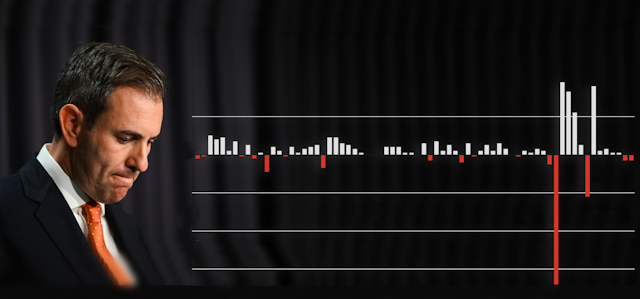Australia’s economy grew a mere 0.4% in the June quarter according to figures released by the Bureau of Statistics on Wednesday, a performance Treasurer Jim Chalmers describes as “steady in the face of unrelenting pressure”.
The lacklustre growth follows growth of 0.4% the previous quarter, and is a step down from the growth of 0.7% in the quarters that preceded it, presenting a stark reminder of the economic challenges caused by rising interest rates as the Reserve Bank attempts to reign in inflation.
If growth continued at that pace for another two quarters, the annual growth rate would barely reach 1.6%, an alarmingly low figure that. For many Australians it probably feels like a recession, because all of the growth was accounted for by population growth, meaning gross domestic product (GDP) per person fell by 0.3% in both March and the June quarters, in a so-called “per capita recession”.
The driving force behind this tepid growth is primarily weak household consumption which grew by only 0.1% in the quarter – far less than Australia’s population.
Households, grappling with the increased cost of essential expenses such as fuel and rent, have resorted to cutting down on savings.
In the three months to June Australia’s household saving ratio plummeted to 3.2%, its lowest rate in 15 years.
How is it possible to have both weak spending and weak saving at the same time?
The answer is that disposable (post tax) income fell by even more.
Real per capita disposable income fell by 2.1% in the June quarter.
Outside of pandemic lockdown years of 2020 and 2021, this was the biggest fall in disposable income per Australian since the 2009 global financial crisis.
The Bureau of Statistics says mortgage interest expenses have almost doubled over the past year as home building (“dwelling investment”) has slid by 0.2% in the quarter and 1.1% over the year.
In better news, business investment has shown resilience, climbing 0.6% in the quarter, and 3.4% over the year driven, driven in part by a rush of tradies attempting to upgrade their cars before a cut in the instant asset write-off limit came into effect on July 1.
Exports climbed 4.3% in the quarter, driven by “education exports” as international students returned.
Gross operating surpluses, a measure of company profits, fell by 8.6% in the quarter driven by a fall in commodity prices which drove down mining profits.
Pressing on profits were higher wage bills – which surged 9.9% outside of mining, reflecting both wage growth and employment growth, outstripping the 5.1% uptick in non-mining profits.
Lower commodity prices also drove another decline in Australia’s terms of trade which fell by 7.9%. The terms of trade measure the price of Australian’s exports relative to the price of imports, meaning that Australia is getting fewer imports for its exports – something that will inevitably feed into our standard of living.
This subdued economic growth is the primary reason the Reserve Bank decided to hold interest rates constant at its board meeting yesterday.
The bank is expecting economic growth to decelerate to an annual rate of only 0.9% by the end of the year, in large measure because of the series of 12 interest rate rises it has imposed since May last year.
One of the bank’s biggest concerns, and one of the government’s biggest concerns, is labour productivity (GDP per hour worked) which slid a further 2% in the quarter to be down 3.6% over the year.
The bank’s outgoing governor Philip Lowe says falling or weak productivity growth makes wage increases more likely to feed inflation, limiting his freedom to cut interest rates, a point he might address in his final speech as governor on Thursday, to be entitled Some Closing Remarks.
Boosting productivity – how much we produce for each hour we work – is important. Our standard of living and the pain we need to inflict to fight inflation will depend on it.

